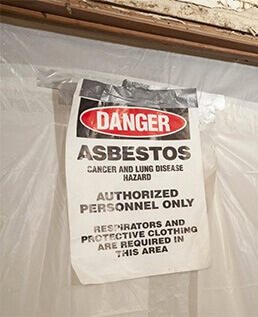How to Tell the Difference Between Asbestos and Fibreglass
Posted in Asbestos Removal, on January 24, 2022
Asbestos abatement in Edmonton and government regulations has led to an abandonment of asbestos as a go-to in construction. New materials are being used in place of the mineral, one being fibreglass. While different in nature, both asbestos fibres and fibreglass are two fibrous materials that can morph into one solid substance when you combine a large number of the fibres together. Thus they can both be found in construction materials.
It’s easy to get them confused, as both are used for similar purposes such as insulation. If you’re having difficulty distinguishing whether a material on your property contains asbestos or fibreglass, contact a professional at Canada’s Restoration Services for asbestos testing in Edmonton.
The main difference is that asbestos fibres are thin, natural minerals, while fibreglass is a human-made product that consists of long, thin fibres of glass. Both can be a risk when inhaled, but asbestos, which breaks down into small microscopic fibres, travelling easily into the lungs. Extended exposure can lead to serious, long-term health conditions like malignant. If there is in fact, asbestos on your property, It’s recommended that you consult with professionals in asbestos abatement in Edmonton, as attempting to address the issue on your own can put your health and safety at risk.
Substituting Asbestos With Fibreglass
 If your property was built between 1950 and 1980, it’s highly likely that asbestos testing in Edmonton will find the mineral present in one form or another. In addition to insulation, other asbestos-containing materials include flooring, ceiling tiles and asbestos-containing cement.
If your property was built between 1950 and 1980, it’s highly likely that asbestos testing in Edmonton will find the mineral present in one form or another. In addition to insulation, other asbestos-containing materials include flooring, ceiling tiles and asbestos-containing cement.
Asbestos was used in vermiculite insulation for its heat resistance, fire resistance, and affordability prior to the 1990s when a large ban prohibited its use. Since then, asbestos abatement in Edmonton has left the construction industry looking for safer alternatives.
But substitutes to asbestos have been developed, with fibreglass being one of them.
Commonly used as an insulator, fibreglass is used in both residential and commercial building insulation, electrical insulation,thermal and acoustic insulation, heat resistance, and plastic and cement reinforcement. It can also be used to make ceilings, walls and for insulating ventilation ducts.
Comparing The Health Risks
Asbestos inhalation can lead to serious, long-term health conditions like malignant mesothelioma cancer, while inhaling airborne fibreglass may cause irritation in the skin, throat, nose and eyes. The mineral can be easily disturbed, sending the fibres airborne and increasing the risk of exposure. To make matters worse, it can take decades for symptoms to develop.
On the other hand, short-term exposure to fibreglass through inhalation may cause irritation throughout the body. The symptoms are often temporary and non-specific, which includes itching, wheezing or coughing. However, being exposed to high levels of airborne fibreglass could aggravate existing lung conditions, such as asthma or bronchitis.
Eliminating Asbestos From Your Property
Distinguishing between asbestos-containing materials and fibreglass-containing materials on your property is no easy task, and it should be left to experts in asbestos abatement in Edmonton at Canada’s Restoration Services. In any event, if you’re concerned that it’s asbestos or if you’re unsure if it’s fibreglass, you should have asbestos testing in Edmonton completed on your property just to be safe and sure.
Our asbestos testing service at Canada’s Restoration Services includes a thorough inspection of your property and taking samples of any materials that may potentially contain asbestos. Those samples are forwarded to a third-party lab for testing and verification.
If the asbestos is confirmed to be present on your property, we move towards a comprehensive and full-scale removal of the mineral. Full containment gear and equipment is used to prevent any cross-contamination. The asbestos-containing material in question is placed in a certified hazard waste bag and disposed of properly.







